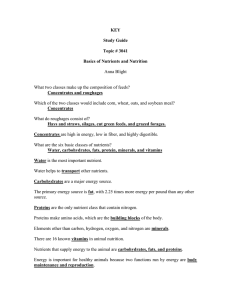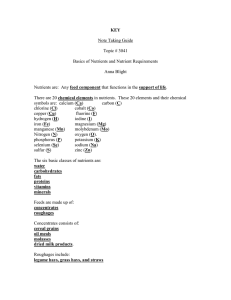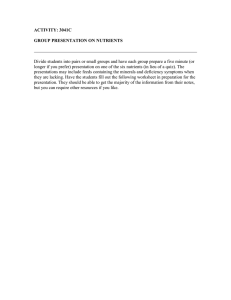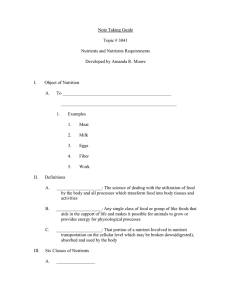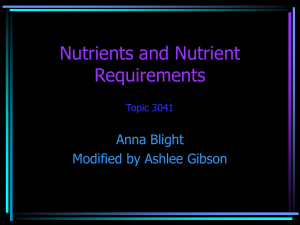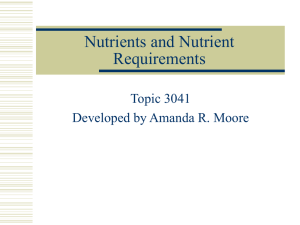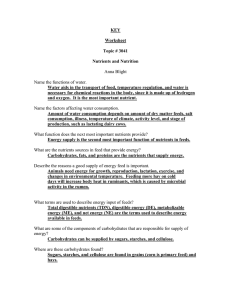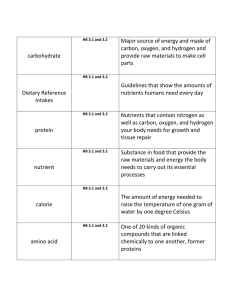Nutrients and Nutrient Requirements Anna Blight Topic 3041
advertisement
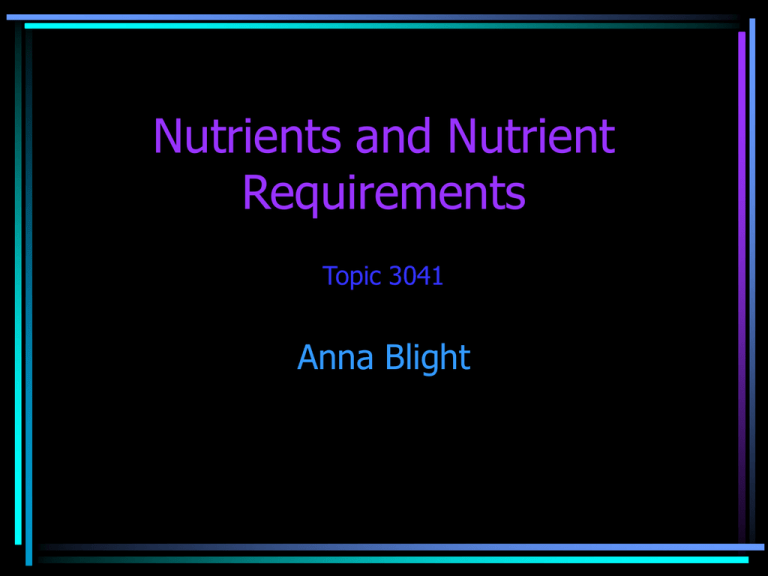
Nutrients and Nutrient Requirements Topic 3041 Anna Blight Nutrients Any feed component that functions in the support of life 20 Chemical Elements in Nutrients • • • • • • • • • • Carbon (C) Calcium (Ca) Chlorine (Cl) Cobalt (Co) Copper (Cu) Fluorine (F) Hydrogen (H) Iodine (I) Iron (Fe) Magnesium (Mg) • • • • • • • • • • Manganese (Mn) Molybdenum (Mo) Nitrogen (N) Oxygen (O) Phosphorus (P) Potassium (K) Selenium (Se) Sodium (Na) Sulfur (S) Zinc (Zn) Six Basic Classes of Nutrients • • • • • • Water Carbohydrates Fats Proteins Vitamins Minerals Composition of Feeds Concentrates Roughages • • • • • • • • Cereal grains Oil meals Molasses Dried milk products Hays and straws Silage Cut green feeds Grazed forages Concentrates • • • • High in energy Low in fiber Highly digestible Includes corn, wheat, barley, oats, milo, soybean meal, linseed meal, and cottonseed meal Roughages • Less digestible than concentrates • Bulkier, coarser feed Water • Most important nutrient • Contains hydrogen and oxygen • Transports other nutrients • Helps maintain normal body temperature Carbohydrates • Major energy source • Contains carbon, hydrogen, and oxygen • Found in grains and hays Fats • Fats and oils are primary energy source • 2.25 times more energy / pound than carbohydrates • Contains carbon, hydrogen, and oxygen Protein • Only nutrient class that contains nitrogen • Protein in feeds contain average of 16% nitrogen • Building blocks of the body • Proteins compose most of the muscle mass Minerals • Elements other than carbon, hydrogen, oxygen, and nitrogen • Macrominerals are required in larger amounts • Microminerals required in smaller amounts • Necessary for healthy body functions Vitamins • • • • • Organic nutrients, contain carbon Provide for very specific body functions Required in very small amounts 16 known vitamins in animal nutrition A, C, D, E, K, choline and the B-complex vitamins •Two basic functions run by energy are maintenance and reproduction •Supplied by nutrients containing carbon •Carbohydrates, fats, and proteins all supply energy •Energy evaluation of feeds is measured by total digestible nutrients, digestible energy, energy for metabolism, and net energy Importance of Nutrition Energy supplied by nutrients are used to drive a variety of body functions and power animal movement Healthy and productive livestock require proper nutrition Reference Taylor, R.E., Field, T.G. (1998). Scientific Farm Animal Production. Upper Saddle River: Prentice Hall. Pp. 269-282.
